case 26 Whos the Coder St Anns Hospital is a 150bed acute ca
case 26
Who’s the Coder?
St. Ann’s Hospital is a 150-bed acute care facility in the Midwest. The facility case mix index averages around 1.850. There are four inpatient coders and five outpatient coders on staff at St. Ann’s, and most have been with the organization for more than five years. All of the coders at St. Ann’s hold American Health Information Management Association (AHIMA) credentials, many of them having both Registered Health Information Administrator and CCS or Registered Health Information Technician and CCS.
St. Ann’s has both inpatient and outpatient regular coding audits done on a quarterly basis. These audits are performed by an external organization that is a nationwide consulting firm. The audits address coding accuracy, appropriateness of documentation, optimal and appropriateness of reimbursement, and opportunities for education of coding staff and physicians. The results of the coding audits at St. Ann’s consistently demonstrate that the coders are performing at a 99% accuracy rate.
The coding staff at St. Ann’s has worked closely with the national consulting firm to ensure that their physician query process is appropriate, compliant, and thorough. The coders at St. Ann’s have developed an excellent rapport with the medical staff, and the physician query process operates in an efficient manner, with less than a 24-hour turnaround time. The coders are well-informed regarding how to present a physician query in a non-leading manner, maintaining the physician’s role as the decision-maker.
Administration at St. Ann’s was contacted by Omar Shariff. Omar is a registered nurse who proposed to the administrators of St. Ann’s that he could implement a program that would improve reimbursement for the organization through improved provider documentation. Omar informed them that he had implemented the program at similar facilities and provided statistical information reflecting the change in reimbursement. Omar explained that he had thoroughly researched St. Ann’s practices and provided an estimate of the amount of increased reimbursement that they could anticipate utilizing his program. The administrators were impressed with his proposal, and they were in the process of reorganizing the case management department, so they created a new position for Omar Shariff.
Omar’s program was based on transferring all inpatient coding responsibilities from the coders in the Health Information Services department to the case management nursing staff on the patient care units. The rationale was that physician query could be performed concurrently during the hospitalization of the patients, so that late documentation after discharge would not indicate inadequate documentation reflective of poor care. Omar undertook the task of training the case management nursing staff how to code in two, four-hour sessions. He assured administration that his staff would fully understand all they needed to know about coding and diagnosis-related group assignment for optimal reimbursement.
Roxanne, the Director of Health Information Services, was informed by administration about the new concurrent program that would be implemented. She was told that this change was not negotiable and that her staff must adjust accordingly to their change in duties. Roxanne met with her inpatient coding staff to communicate the changes as they were outlined by administration. They would no longer be doing any actual coding; rather, their job descriptions changed to case abstracting and data entry. Roxanne shared the multiple concerns expressed by her coding staff. The concerns expressed by the coders included:
Omar does not hold any formal coding credentials.
The case management nurses have never had any other coding education.
Coding is not something that can be learned and mastered in two, four-hour sessions.
The existing coding staff members at St. Ann’s have AHIMA credentials that indicate they are at mastery level in their coding skills.
Coding audits from a nationwide consulting firm indicate that the existing coding staff members have consistently been coding at 99% accuracy.
Case management nurses have not had formal education regarding coding and reimbursement compliance, creating potential for noncompliant coding practice.
What would happen to the existing coders’ jobs?
Roxanne recognized that she had expressed the same concerns to administration when she was informed about the change and that this was not negotiable. She assured them that they would not be laid off as the result of the changes. The volume of outpatient encounters had increased so that some of the coders would be transferred to the outpatient coding area, and the rest would work on data entry.
Two of the inpatient coders resigned immediately, accepting positions at other local hospitals. The remaining coders continued to pursue compliance concerns with the changes being made and to research Omar’s history. They learned through their local network that Omar had implemented his program in four other hospitals in the state and been terminated shortly after each time. Eventually, they learned that he had been associated with a consulting firm that had been cited for fraudulent coding practices. The coders took these concerns to Theresa and then to the compliance officer and administration. They were repeatedly told that Omar had gone through a background check prior to his employment and that nothing significant turned up.
The previous coders who had since become abstractors for the cases coded by the case management nurses noted many significant errors in coding. The errors included the following:
Sequencing principal diagnosis other than what was indicated by the attending physician without approval
Case management nurses writing diagnoses on the face sheet and coding without physician approval
Physician query forms written with blatantly leading questions
Incorrect code assignment
Missing codes for complications and comorbid conditions
The abstractors took a sampling of the records with the errors to Theresa, the compliance officer, and the organization administrators. They were told that their jobs were no longer to code and that they should not be wasting time evaluating the work of the case managers. In response, the abstractors developed low morale and a decreased sense of loyalty to St. Ann’s.
Discussion Questions
What additional “flags” should Theresa be suspicious of in this case?
Are there any issues presented in this case that are not in compliance with the AHIMA Code of Ethics?
Does Theresa have a legitimate case regarding the changes?
What internal and external forces impact the concerns of the inpatient coders in this case? Theresa’s concerns?
Internal
External
What ethical concerns are presented in this case?
What legal issues need to be considered regarding this case?
CASE 27
New Kid on the Block
Shondra Johnson is a new graduate of a Health Information Technology program. She successfully passed her Registered Health Information Technician (RHIT) exam three months ago. She was hired by Springfield General Hospital as an outpatient coder immediately after passing her RHIT exam. This is Shondra’s first “real job,” and she has a high sense of determination to be successful. Shondra thoroughly read all of the policy and procedural manuals during her orientation, taking notes and paying close attention to details outlined in the organizational compliance manual.
During her training period, Shondra worked with Geoffrois, an experienced outpatient coder who has been at Springfield General for 18 years. Geoffrois reinforced the coding policy that Shondra reviewed, especially regarding productivity and the unbilled accounts report. It was obvious to Shondra that this organization wanted to keep their unbilled accounts to a minimum. Springfield General’s unbilled accounts at this time were at an all-time high, especially the outpatient accounts, because they had been short-staffed in the outpatient coding area for six months.
Shondra encountered several outpatient records with questionable documentation during her training period. Rather than showing Shondra how to handle these records, Geoffrois simply took them and told Shondra that he would handle them and show her at a later date what to do with them after they were working with less of a coding backlog. Shondra did not question Geoffrois about this because she just thought that he was helping to reduce the outpatient coding backlog.
Another occurrence during Shondra’s training period that she did not question was calls from the outpatient billing department that Geoffrois insisted on handling. Geoffrois would not allow Shondra to answer the phone, telling her that it would be more efficient if he would handle the calls on his own because some of them were complicated and required the knowledge of an experienced coder. This explanation made sense to Shondra, who wanted to focus on mastering her current tasks.
Two months had passed, and Geoffrois had to leave town for a death in his family. Shondra was comfortable with her outpatient coding duties and thought all would go well during Geoffrois’ absence. In fact, she secretly enjoyed having some time to do her job without Geoffrois hovering over her every second. All was going smoothly until the phone rang in the outpatient coding area. Shondra was excited to finally have the opportunity to take care of one of the phone requests that Geoffrois had reserved only for himself. The call was from Annette, one of the Medicare billing representatives. Annette requested that Shondra remove a V code from an account because Medicare would not pay the account with the code on it. Shondra took down the information and told Annette that she would get back to her. Shondra pulled the record and determined that the V code was necessary on the account and that the documentation was highly supportive to include the code. She called Annette back and informed her of the findings. Annette stated that with the V code, they would not be reimbursed for the encounter. Shondra asked Annette if she could discuss the case with her director when she arrived, which was acceptable.
A few minutes later, Annette called again. This call was about a patient who was being billed for a diagnostic mammogram but did not have a diagnosis code to support medical necessity. Annette asked Shondra whether she could change the code from the screening code to something on the national coverage determination list that would support a diagnostic mammogram. Shondra took down the information, pulled the record, and as far as she could tell, could not find a diagnosis that would support a diagnostic mammogram. Shondra decided to hold this case until Theresa, her director, arrived.
Annette’s next call was for a case that Geoffrois had coded. The patient had an arthroscopy of the right knee with a meniscectomy. Geoffrois had assigned two CPT codes, one for the arthroscopic meniscectomy of the knee and one for a diagnostic arthroscopy of the knee. Annette requested that Shondra add modifier 59 so that they would be paid for both procedures. Shondra pulled the record and called Annette back. “This one is easy,” she thought to herself. Shondra explained to Annette that she would remove the diagnostic arthroscopy code because that was unbundling in this case. Annette told Shondra that it was their facility policy to always assign the code for the diagnostic procedure if a therapeutic procedure was done and that as long as they assigned modifier 59, it would be reimbursed just fine. Shondra decided again to hold the record until Theresa arrived.
Theresa arrived, and Shondra took all three records in to discuss with her right away. Theresa explained to Shondra that things in the real world are different from what she read about in her textbooks. She told her that general coding guidelines are suggested best practice, but in reality, things need to be done a little differently to maintain the financial well-being and survival of the facility. She explained that modifiers were created for circumstances like this and that it was appropriate to follow Annette’s instructions. Shondra insisted that she was uncomfortable with this. Theresa said that it would be fine to leave these calls for Geoffrois\'s return and that she would handle them for Shondra during Geoffrois’s absence.
Shondra remembered the information presented about organization compliance during her orientation. She contacted the internal compliance contact and was directed to Mark Summers, the Chief Financial Officer, who also serves as the Chief Compliance Officer for the facility. Mark, realizing Shondra’s lack of experience, provided an explanation similar to that given by Theresa regarding the difference between textbook knowledge and real-life experience. He explained the importance of preserving the bottom line for the organization to survive in a health care world dictated by Medicare reimbursement. Shondra did not feel any better about the situation after her meeting with Mark and doubted not only her decision to work at Springfield General, but also her decision to work as a medical coder.
Discussion Questions
How does the American Health Information Management Association Code of Ethics address the situations presented in this case?
Are there other “safety nets” for Shondra because the organization’s internal reporting system for compliance issues was not effective?
What internal and external forces impact Shondra’s concerns in this case?
Internal
External
What ethical concerns are presented in this case?
?
What legal issues need to be considered regarding this case?
.
Solution
case 26
Who’s the Coder?
Discussion Questions
1. What additional “flags” should Theresa be suspicious of in this case?
Answer 1: Theresa should be suspicious of the following:
a) Errors in coding may be taken as unethical practice as per “AHIMA” (code of ethics).
b) The reputation of the hospital may suffer due to wrong coding and physician forms being filled incorrectly without physician approval.
c) The missing codes can again create a problem for the hospital under medical trade practices norms.
2. Are there any issues presented in this case that are not in compliance with the AHIMA Code of Ethics?
Answer 2: Yes, there are issues of non compliance with the “AHIMA” (code of ethics), as follows:
a) Assigning codes without physician approval and physician query forms written with blatantly leading questions are not allowed.
b) Sequencing principal diagnosis which is not condoned by the physician in attendance is against code of ethics.
c) Engaging in negligent coding practices.
3. Does Theresa have a legitimate case regarding the changes?
Answer 3: Yes, Theresa has a legitimate case regarding the changes initiated by Omar. Which are as follows:
a) Inadequate or late documentation which was reflective of poor care post discharge would be eliminated.
b) The chances of coding errors and confusion in documentation would be reduced.
c) The documentation of the hospital will become prompt and efficient
d) The overall time would be saved for the patients.
4. What internal and external forces impact the concerns of the inpatient coders in this case? Theresa’s concerns?
Answer 4:
Internal:
Inpatient coder’s case:
a) Omar’s plan would lead to their being terminated shortly.
b) Hospital might suffer due to incorrect coding as Omar holds no former coding credentials.
c) Their role has been limited to data entry
Theresa’s Concerns:
a) Omar’s program might increase the inefficiency in the coding practices of the hospital which are currently audited at 99%.
b) Violating the “AHIMA” (code of ethics).
External
Inpatient coder’s case:
a) The need for the coders in all hospitals might get eliminated.
b) They would lose monopoly over coding and their market value would diminish/get eliminated.
Theresa’s concern:
a) The reputation of the hospital might suffer.
b) The audit rating might fall.
5. What ethical concerns are presented in this case?
Answer 5: The ethical concerns are as follows:
a) The patients might get incorrect or misleading information/diagnosis.
b) The leading questions on the query forms can create distress in the patients.
6. What legal issues need to be considered regarding this case?
Answer 6: The legal issues are as follows:
a) The compliance procedures not being followed by the hospital might violate “AHIMA” (code of ethics) resulting in the hospital losing its license.
b) Diagnosis not approved by the physician and shared with the patient can mislead patients who could go for legal proceedings.
CASE 27
New Kid on the Block
Discussion Questions
1. How does the American Health Information Management Association Code of Ethics address the situations presented in this case?
Answer 1: The AHIMA clearly states as follows:
In their Ethical Principles:
2. Are there other “safety nets” for Shondra because the organization’s internal reporting system for compliance issues was not effective?
Answer 3: Yes Shondra if she has sufficient proof and evidence can take legal recourse. She has to be strong and go meet Health compliance Directors in the health Departments.
3. What internal and external forces impact Shondra’s concerns in this case?
Answer 3: Shondra’s concerns are impacted as follows:
Internal
a) The organization is rampantly following incorrect coding methods to make financial gains.
b) Directed to the financial office are not interested in following ethical practices or addressing her concerns
External
a) The organization is following incorrect coding practices which were not as per “AHIMA” (code of ethics).
4. What ethical concerns are presented in this case?
Answer 4: The ethical concerns are as follows:
a) The springfield is hand in glove with medicare to clear expenses which are not eligible by code changing or eliminating the code, so the patient could get reimbursed.
b) They want Shondra to follow their practices and tow their line saying the world does not work according to textbooks.
5. What legal issues need to be considered regarding this case?
Answer 5: The legal issues are as follows:
a) The springfield could lose it’s license and the directors could be arrested.
b) The evidence of medicare company and hospital working illegally can lead to persecution in this case.
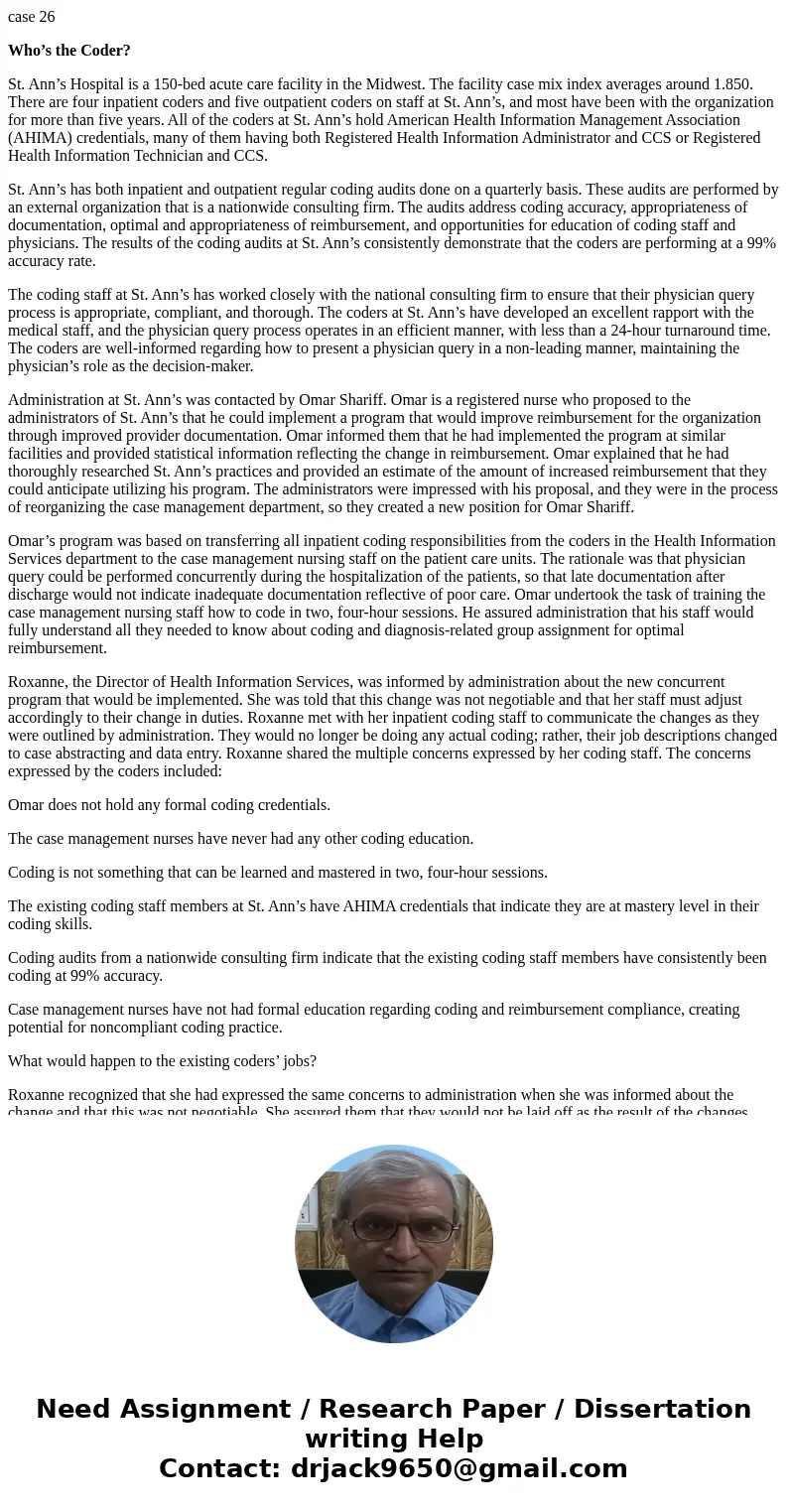
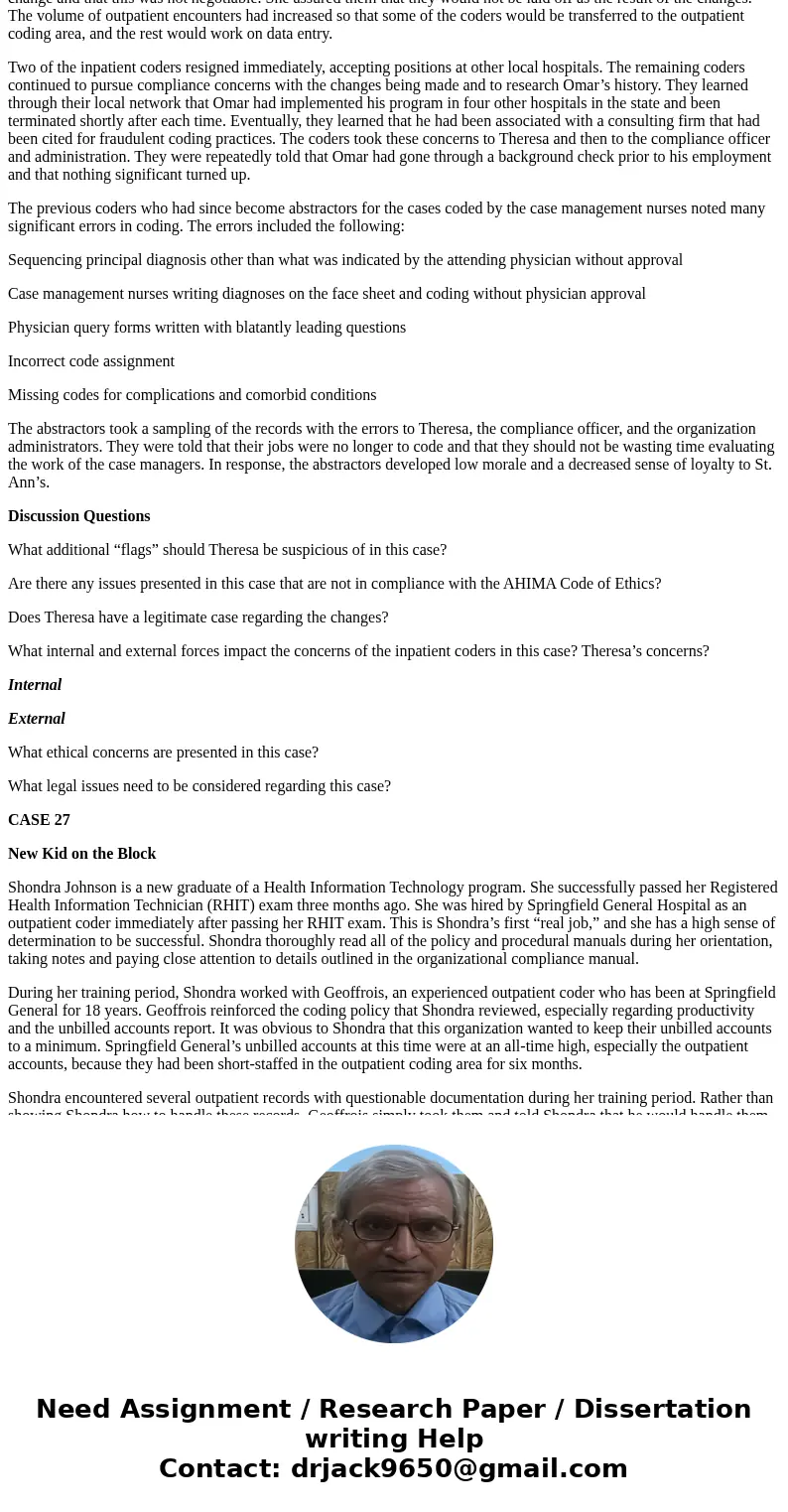
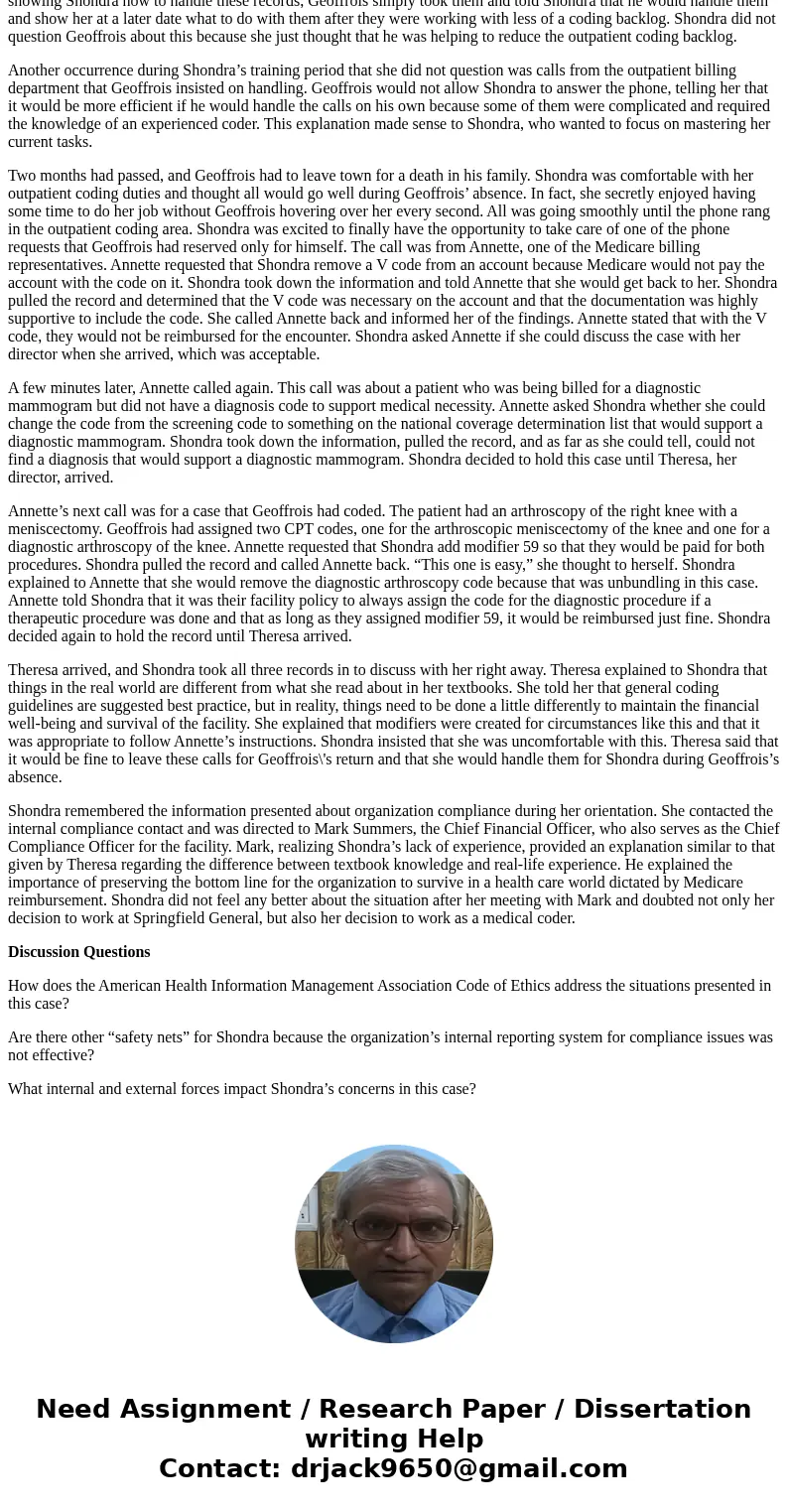
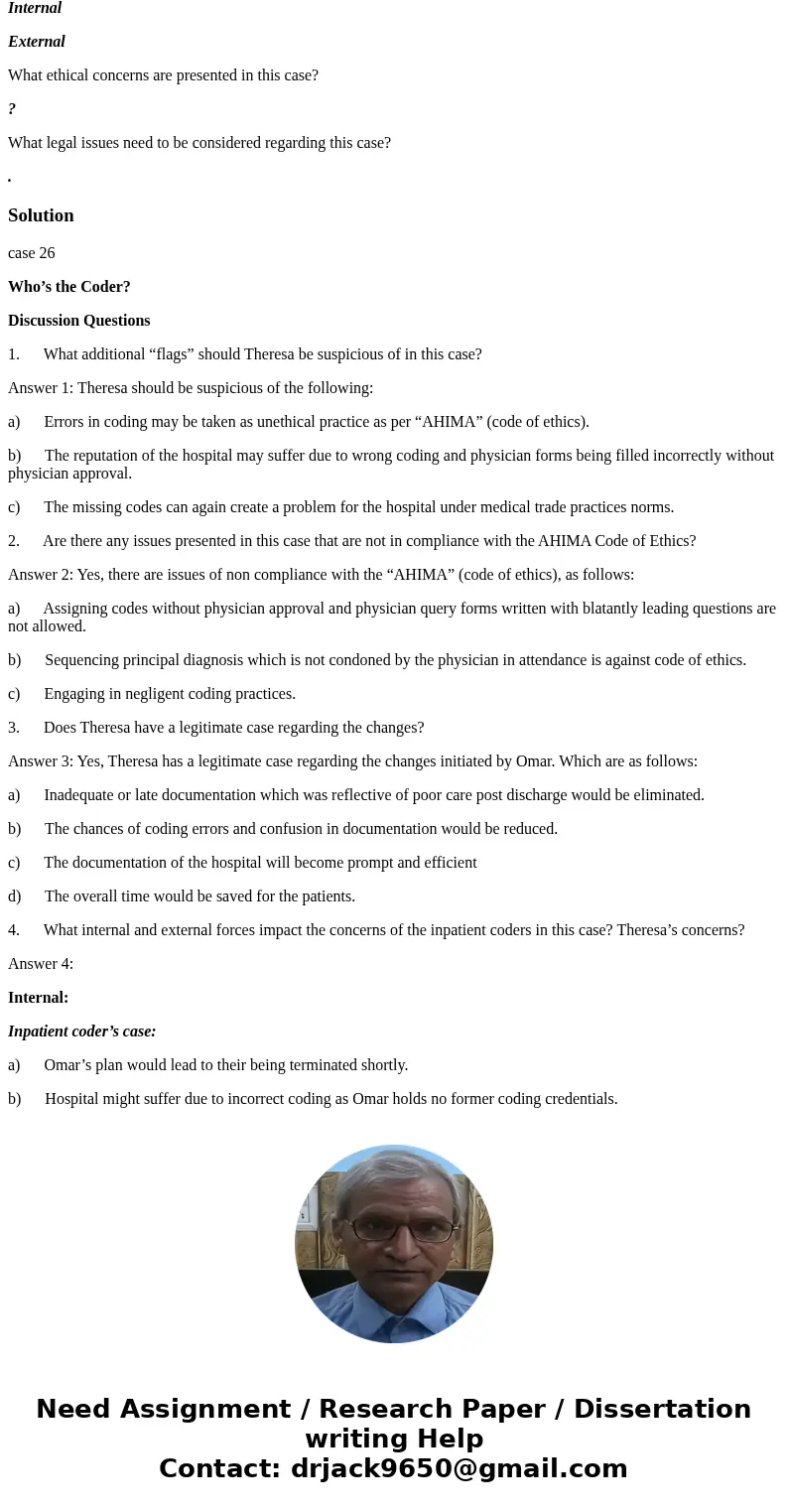
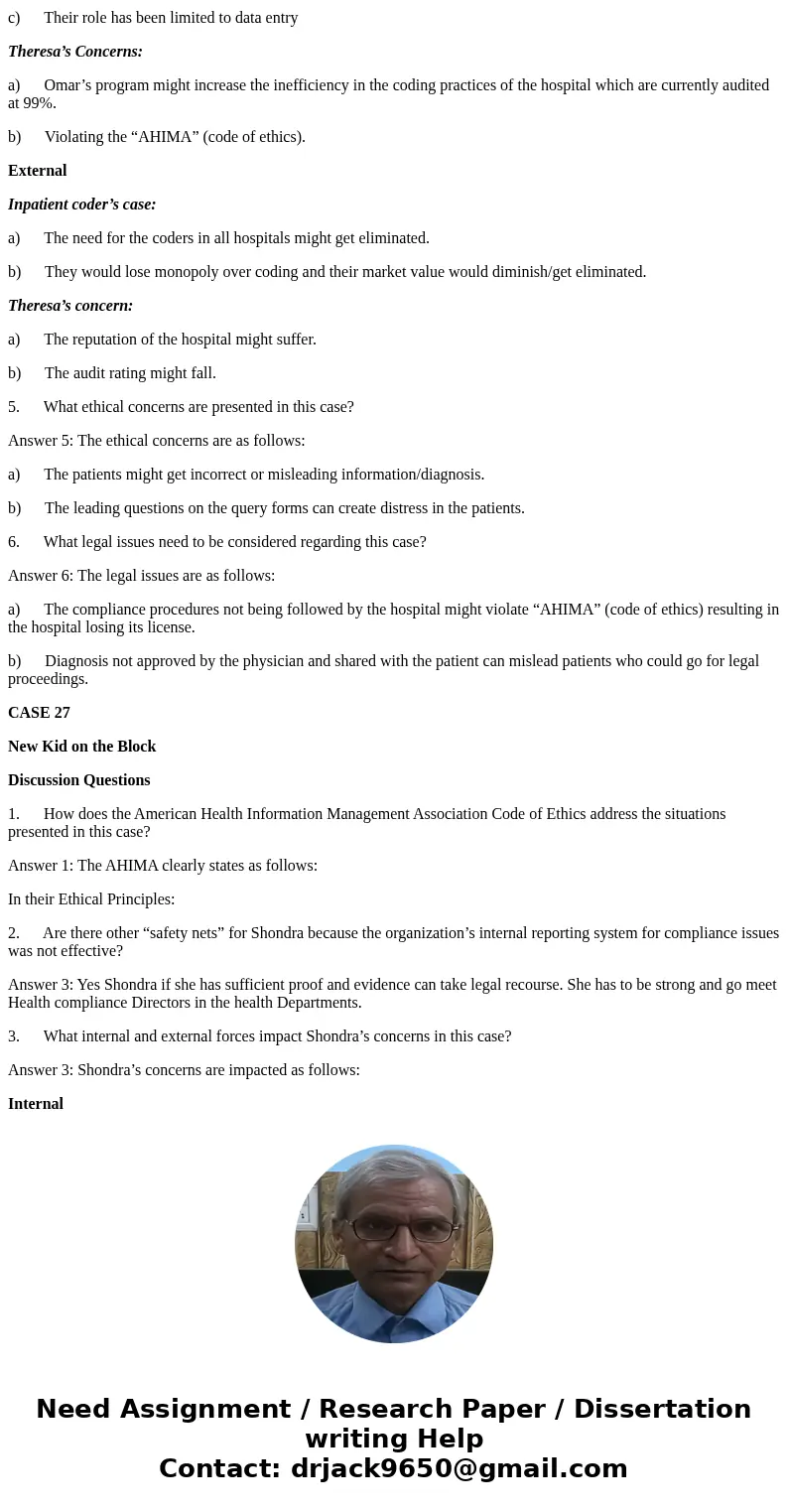
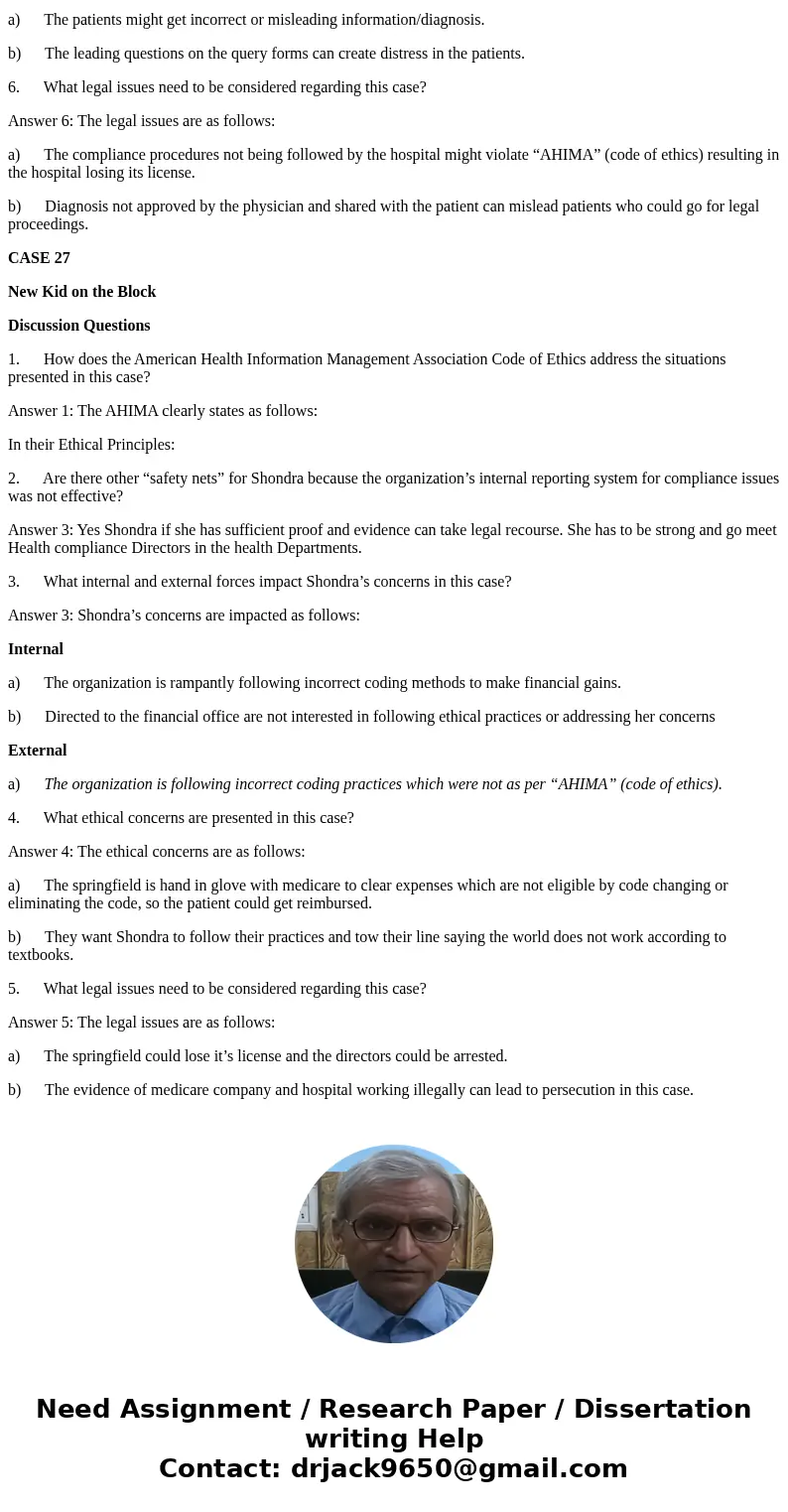
 Homework Sourse
Homework Sourse